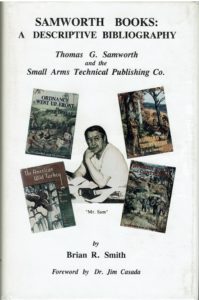How do you know when you’ve got a problem with bibliophilia?
One clue is when you start buying bibliographies.
Samworth Books: A Descriptive Bibliography by Brian R. Smith. The Marksman’s Bookshelf, 1990.
Between 1926 and 1954 (when he retired), Thomas G. Samworth published 47 books under the imprint of the Small Arms Technical Publishing Company (SATPCO). Pretty much every one of those books went on to become important works of firearms or military history. Among them were:
- Elmer Keith’s Big Game Rifles and Cartridges and Sixgun Cartridges and Loads.
- John “Pondoro” Taylor‘s African Rifles and Cartridges.
- The four war books: McBride’s A Rifleman Went to War, Dunlap’s Ordnance Went Up Front, Shore’s With British Snipers to the Reich, and George’s Shots Fired In Anger.
And the list goes on. Many of these books have been reprinted by other publishers due to their continuing high demand (and corresponding prices).
Mr. Smith started off with a copy of A Rifleman Went to War, and, as he puts it, “from that tiny flake a massive snowball formed”. He spent the next 15 years collecting and documenting (with the help of other collectors: I think the overlap between book people and gun people is larger than anyone suspects) the various Samworth volumes and assembled this book.
And his bibliography is a joy. Mr. Smith includes quotes from Samworth promotional material, editions, points of issue, reprint editions from other publishers, photos of the dust jackets (in black and white), and even a mini-biography of Mr. Samworth himself.
The late Mr. Samworth sounds like an interesting gent. He grew up shooting, worked for Du Pont and suggested many improvements to their powder making and ammunition manufacturing, and then went on to edit “Arms and the Man” (the official NRA publication: under his editorship, it was renamed “The American Rifleman”).
While he was editor, he got the NRA to publish their first book, Amateur Gunsmithing by Townsend Whelen. It was about a break-even proposition for the NRA, and his bosses didn’t want to publish any more books. So he struck out on his own and founded SATPCO, working closely with Whelen in the first few years.
The people who know him make Mr. Samworth sound like a bit of a contradiction: he’s described as irascible, somewhat short tempered, and publicity shy. But (quoting Smith): “If approached by a total stranger with a question about a particular firearm, rest assured that man came away sometime later after a detailed discussion, knowing virtually all there is to know about the weapon.”
When he was 84, Mr. Samworth deeded his land and property to the South Carolina Wildlife Department as a hunting preserve. It was renamed the Thomas G. Samworth Game Management Area in 1978. Mr. Samworth moved out of his house and into a trailer in the yard, though he kept a room in the house as his study: the rest of the house was used by South Carolina wildlife biologists as a base for research. He passed away in 1981 at the age of 93.
I paid $30 (plus tax and shipping) for this from a dealer on ABE, and I don’t begrudge a penny of it. This is a delightful book to read. I only have two minor complaints, and one of those isn’t really a complaint.
- Because this is a 30 year old book, it obviously isn’t up to date with the latest information about reprints. Mr. Smith is very up front about what he does and doesn’t know (for example, rumors of variant issues, dust covers and the possible lack of them, etc.) If he’s still around, I’d love to sit down with him and talk about what he’s found out in the past 30 years.
- Now I have an expensive new hobby: collecting original Samworth books. I only have one Samworth original at the moment (and several post-1990 reprints from other publishers) but I ordered my second one yesterday.
